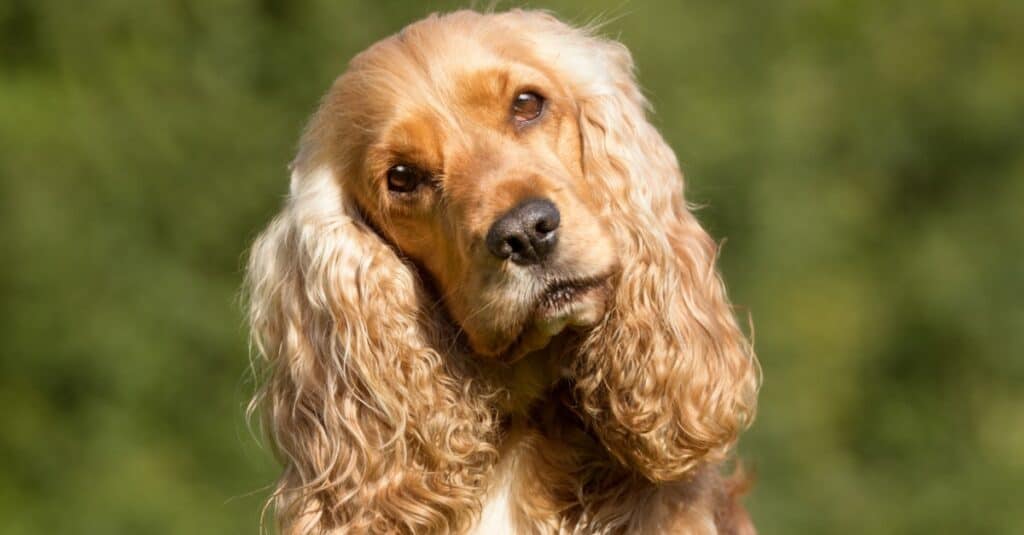Cocker Spaniels were bred to hunt birds such as quail and woodcocks. This is where they got the name “cocker.” They work closely with their human hunting companions and, for this reason, dislike being alone. Cockers are sociable, agreeable, and smart.
In this article, we’ll discuss what Cocker Spaniels were bred for, their history, and how their breeding impacts their appearances and personalities.
Cocker Spaniels Were Bred to Hunt
Cocker Spaniels were bred to hunt quail and woodcocks. This is actually how they got their name!
They’re quick dogs with great noses. Standing just 13.5-15.5 inches tall and weighing less than 30 pounds, these small pups can easily navigate grounds that are difficult for taller hunting dogs to traverse, such as areas with thick brush.
That said, modern-day American Cocker Spaniels tend to be poorly bred when compared to their ancestors and modern English Cocker Spaniels. As a result, they have many more hereditary health problems in comparison.

Cocker Spaniels were bred to hunt birds such as quail and woodcocks. This is where they got the name “cocker.”
©Labrador Photo Video/Shutterstock.com
Cocker Spaniel History
Cocker Spaniels used to be referred to as Field Spaniels. They originated in the United Kingdom, and evidence of their existence dates back to the 1600s.
Eventually, they were brought to the United States, where they would end up bred to have shorter legs and long backs. This occurred to the detriment of the dogs, as it makes them much more susceptible to spinal injuries and other back problems. Unfortunately, this poor breeding continues today.
Today, there are two Cocker Spaniel breeds: the American Cocker Spaniel (called simply the Cocker Spaniel by the American Kennel Club) and the English Cocker Spaniel.
English Cockers tend to have healthier backs in comparison due to better breeding practices. As always, it’s important to shop only with reputable breeders that complete all recommended genetic health testing. This isn’t to be confused with DNA test kits, which some backyard breeders try to pass off as enough.
How Breeding Affects Cocker Spaniels’ Appearance
Cocker Spaniels are small and light to make their way through the brush easily. This is also said to make them more heat tolerant than larger hunting dogs, perhaps because they’re exerting themselves less.
They have long double coats that help to protect them from the elements. Their coats help protect them from sunburn, keep them drier in the rain, and protect their skin from bramble that might injure exposed skin as they pass through.
Cocker Spaniel’s coats also help them to regulate their temperature, keeping them insulated in winter and cool in summer. This is why it’s not okay to shave a double-coated dog, as it won’t actually make them cooler but instead more prone to overheating as well as sunburn.
Floppy ears help Cockers hunt by scent as they work to pick up scents and herd them to their noses. Speaking of noses, they also have long snouts that help them trail scents.
Often, Cocker Spaniels have docked tails. They aren’t born this way but have them docked–essentially amputation.
This cruel practice is thought by some to reduce the risk of tail injuries, but it isn’t proven to have a substantial effect.
Less than 0.04% of dogs have their tails injured each year. According to the American Veterinary Medical Association (AVMA), 500 dogs would need to have their tails docked to prevent a single injury.
Most people dock their dog’s tails for aesthetic reasons. As the numbers above show, there is no true medical argument to be made. Tail docking also harms a dog socially, and sometimes psychologically or physically, for the rest of their lives.

Floppy ears help Cockers hunt by scent as they work to pick up scents and herd them to their noses.
©iStock.com/Bigandt_Photography
How Breeding Affects Cocker Spaniels’ Temperament
Cocker Spaniels were bred to hunt alongside their owners, and don’t seem as prone to wander as some other hunting dogs–though it’s still a good idea to keep them on-leash or enclosed so that they don’t run off after small animals.
Because of this close companionship, they tend to make good family dogs. They’re friendly toward children, other dogs, and strangers. Like all dogs, they should still be supervised around kids and introduced to new people and animals slowly.
Cockers are also pretty adaptable, and they’re easy to train. They’re smart dogs that enjoy a variety of activities and love being around their people.
This also makes them prone to separation anxiety. A Cocker Spaniel isn’t a good dog for you if you live alone and are gone most of the day.
They’re also quite energetic and enjoy play that mimics hunting, such as games of fetch or tug. On walks, they will like to sniff more than other dogs and will likely take a leisurely pace as they explore the area with their nose. This shouldn’t be discouraged as it’s a great activity for mental enrichment.
Lastly, like many hunting dogs, Cocker Spaniels are quite vocal. They may especially get excited if they spot something they’d like to chase.
Final Thoughts
I hope this has helped to answer your questions about Cocker Spaniel breeding and how the breed originated. Cocker Spaniels are smart, quick, and reliable hunting dogs, but they also make wonderful companions when kept solely as pets!
Thank you for reading! Have some feedback for us? Contact the AZ Animals editorial team.








